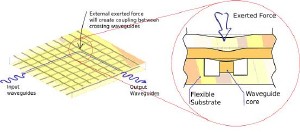Oct 7 2008
IMEC's associated laboratory at the Ghent University, INTEC, has made the first functional optical links embedded in a flexible substrate. The links include optical waveguides, light sources, and detectors. With this technique, it becomes possible to make foils that sense changes in pressure. Such sensing, skin-like foils could be used for monitoring irregular or moving surfaces, e.g. in robots, pliable machinery, or as an artificial skin.
 Principle of the array waveguide sensor.
Principle of the array waveguide sensor.
Integrated optical interconnections have the advantage that they are insensitive to electromagnetic interference, applicable in harsh environments, and highly sensitive. Last year, IMEC already reported embedded optical links on rigid surfaces. The current research takes optoelectronics one step further. Standard commercially available GaAs photodetectors and GaAs VCSELs (vertical-cavity surface-emitting laser) are thinned down to 30µm. Next, they are embedded into a flexible foil of optical transparent material and optically coupled with embedded waveguides and out-of-plane micromirrors. The resulting structure shows good adhesion and flexible behavior.
With this technology, IMEC is working on two types of sensors: array waveguide sensors and optical fiber sensors. Both can be used for sensor foils. Array waveguide sensors rely on the change in coupling between arrays of crossing waveguides. Two layers of polymer waveguides are separated by a thin layer of soft silicone. When no pressure is applied, no crosstalk is detected. But when pressure is applied to the foil, the distance between the waveguides in the separated layers decreases, and light is transmitted from one layer to the other. This low-cost sensor is ideally suited for high-density pressure sensors on small areas.
Optical sensing foils combine two technologies that have lately seen a growing interest: integrated optical interconnections, and flexible, stretchable electronics. The ambition of researchers is to create a flexible and stretchable skin-like foil sensitive to touch, pressure, or deformation. Such artificial skin could be used in medical and industrial environments. To this aim, a group of European research institutes, including IMEC, are collaborating in the 7th Framework project PHOSFOS (Photonic Skins For Optical Sensing).
PHOSFOS will develop photonic foils based on optical fiber sensors. These foils are targeted at applications in civil engineering and medicine. They will, for example, continuously monitor the integrity and the behavior of buildings, dams, bridges, roads, or tunnels. Other uses are monitoring aircraft wings, helicopter blades, or windmill blades. They will enable early warning of failure or anomaly. Skin-like PHOSFOS membranes will also be used in long-term monitoring of respiration and cardiac activity, as well as the detection of pressure points under bed-ridden patients.